Co-Cultivation of Potential Probiotic Strains Isolated from Water Kefir for Fermented Green Tea Beverage
Abstract
1. Introduction
2. Materials and Methods
2.1. Samples Preparation
2.2. Fermentation of Green Tea Beverage Using Co-Cultures of Identified Strains
2.3. LAB and Yeasts Isolation and Enumeration
2.4. Molecular Identification of Isolated Strains
2.4.1. LAB 16S Identification
2.4.2. 18S Yeasts Identification
2.4.3. Phylogenetic Analysis
2.4.4. Phenotypic Characterization
2.5. Characterization of Isolated Strains
2.5.1. Acidity Tolerance
2.5.2. Bile Salt Resistance
2.5.3. Salinity Tolerance
2.5.4. Auto-Aggregation Test
2.5.5. Hydrophobicity Activity
2.5.6. Antibiotic Resistance of LAB Strains
2.5.7. Antimicrobial Activity of LAB Strains
2.5.8. Cytotoxicity Using Caco-2 Cell
2.5.9. Cumulative Probiotic Potential of Identified Strains
2.6. Physico-Chemical Analysis of Fermented Beverage
2.6.1. Determination of pH and Total Titratable Acidity
2.6.2. Determination of Total Phenolic Compounds
2.6.3. Determination of Antioxidant Activity
2,2-Diphenyl-1-Picrylhydrazyl Radical Scavenging Assay
2,2′-Azino-bis(3-ethylbenzothiazoline-6-sulfonic Acid) Diammonium Salt Radical Scavenging Assay
Power-Reducing Activity
2.6.4. Sensory Analysis
2.7. Anti-Inflammatory Activity of Strains and Fermented Beverage
2.8. Statistical Analysis
3. Results
3.1. Phenotypic Characterization of LAB and Yeast Strains
3.2. Molecular Identification of Selected LAB and Yeasts
3.3. Probiotic Potential of Identified Strains
3.3.1. Tolerance to Acidity, Salinity, and Bile Salts
3.3.2. Auto-Aggregation of Identified Strains
3.3.3. Hydrophobicity of Identified Strains
3.3.4. Antimicrobial Activity of Identified LAB Strains
3.3.5. Antibiotic Resistance of Identified LAB Strains
3.3.6. Cytotoxicity of Identified Strains
3.3.7. Anti-Inflammatory Activity of Identified Strains
3.3.8. Cumulative Probiotic Potential of the Identified Strains
3.4. Fermentation of Green Tea Infusion by Co-Culture of Isolated Strains
3.4.1. Microbial Growth and Acidification During Fermentation
3.4.2. Total Phenolic Content and Antioxidant Activity of Fermented Beverages
3.4.3. Sensory Analysis of the Different Fermented Beverages
3.4.4. Anti-Inflammatory Activity
4. Discussion
4.1. Probiotic Properties of Isolated Strains
4.2. Physico-Chemical and Sensory Properties of Fermented Beverages
5. Conclusions
Author Contributions
Funding
Institutional Review Board Statement
Informed Consent Statement
Data Availability Statement
Acknowledgments
Conflicts of Interest
Abbreviations
| LAB | lactic acid bacteria |
| Lc. citreum | Leuconostoc citreum |
| L. lactis | Lactococcus lactis |
| S. cerevisiae | Saccharomyces cerevisiae |
| CPP | cumulative probiotic potential |
| ITS | internal transcribed spacer |
| PDA | potato dextrose agar |
| MRS | De Man–Rogosa–Sharpe |
| DMEM | Dulbecco’s modified eagle medium |
| PCR | polymerase chain reaction |
| OD | optical density |
| CFU | colony forming unit |
| PBS | phosphate buffered saline |
| DPPH | 2,2-diphenyl-1-picrylhydrazyl |
| ABTS | 2,2′-Azino-bis(3-ethylbenzothiazoline-6-sulfonic acid) |
| ELISA | enzyme-linked immunosorbent assay |
| Tnf-α | tumor necrosis factor alpha |
| LPS | lipopolysaccharide |
References
- Tan, K.X.; Chamundeswari, V.N.; Loo, S.C.J. Prospects of kefiran as a food-derived biopolymer for agri-food and biomedical applications. RSC Adv. 2020, 10, 25339–25351. [Google Scholar] [PubMed]
- Lynch, K.M.; Wilkinson, S.; Daenen, L.; Arendt, E.K. An update on water kefir: Microbiology, composition and production. Int. J. Food Microbiol. 2021, 345, 109128. [Google Scholar]
- Rodríguez, M.A.; Fernández, L.A.; Díaz, M.L.; Gallo, C.A.; Corona, M.; Evans, J.D.; Reynaldi, F.J. Bacterial diversity using metagenomics of 16s rDNA in water kefir, an innovative source of probiotics for bee nutrition. Rev. Argent. Microbiol. 2024, 56, 191–197. [Google Scholar]
- Kumar, M.R.; Yeap, S.K.; Mohamad, N.E.; Abdullah, J.O.; Masarudin, M.J.; Khalid, M.; Leow, A.T.C.; Alitheen, N.B. Metagenomic and phytochemical analyses of kefir water and its subchronic toxicity study in BALB/c mice. BMC Complement. Med. Ther. 2021, 21, 183. [Google Scholar]
- Zannini, E.; Lynch, K.M.; Nyhan, L.; Sahin, A.W.; O’ Riordan, P.; Luk, D.; Arendt, E.K. Influence of substrate on the fermentation characteristics and culture-dependent microbial composition of water kefir. Fermentation 2023, 9, 28. [Google Scholar]
- Kang, Y.R.; Chang, Y.H. Structural characterization and prebiotic activity of rhamnogalacturonan-I rich pumpkin pectic polysaccharide extracted by alkaline solution. Int. J. Biol. Macromol. 2024, 270 Pt 1, 132311. [Google Scholar]
- Cufaoglu, G.; Erdinc, A.N. An alternative source of probiotics: Water kefir. Food Front. 2023, 4, 21–31. [Google Scholar]
- Tan, L.L.; Tan, C.H.; Ng, N.K.J.; Tan, Y.H.; Conway, P.L.; Loo, S.C.J. Potential probiotic strains from milk and water kefir grains in Singapore—Use for defense against enteric bacterial pathogens. Front. Microbiol. 2022, 13, 857720. [Google Scholar]
- Georgalaki, M.; Zoumpopoulou, G.; Anastasiou, R.; Kazou, M.; Tsakalidou, E. Lactobacillus kefiranofaciens: From isolation and taxonomy to probiotic properties and applications. Microorganisms 2021, 9, 2158. [Google Scholar] [CrossRef]
- Limbad, M.J.; Maddox, N.G.; Hamid, N.; Kantono, K. Functional properties of microorganisms isolated from formulated sourdough, coconut water kefir, and kefir. Fermentation 2024, 10, 327. [Google Scholar] [CrossRef]
- Abdi, A.; Gatri, E.; Filannino, P.; M’Hir, S.; Ayed, L. Formulation design and functional characterization of a novel fermented beverage with antioxidant, anti-Inflammatory and antibacterial properties. Beverages 2025, 11, 27. [Google Scholar] [CrossRef]
- Laureys, D.; De Vuyst, L. Microbial species diversity, community dynamics, and metabolite kinetics of water kefir Fermentation. Appl. Environ. Microbiol. 2014, 80, 2564–2572. [Google Scholar]
- Al-Kotami, S.; Abou-Ghorrah, S.; Yazaji, S. Detection and isolation of lactic acid bacteria and its use as local starters in Syrian Akawi cheese processing. Int. Food Res. J. 2015, 22, 1699–1704. [Google Scholar]
- Zhang, J.; Wu, C.; Du, G.; Chen, J. Enhanced acid tolerance in Lactobacillus casei by adaptive evolution and compared stress response during acid stress. Biotechnol. Bioprocess Eng. 2012, 17, 283–289. [Google Scholar]
- Yazdi, M.K.; Davoodabadi, A.; Khesht Zarin, H.R.; Tajabadi Ebrahim, M.; Soltan Dallal, M.M. Characterization and probiotic potential of lactic acid bacteria isolated from Iranian traditional yogurts. Ital. J. Anim. Sci. 2017, 16, 185–188. [Google Scholar]
- Fadda, M.E.; Mossa, V.; Deplano, M.; Pisano, M.B.; Cosentino, S. In Vitro screening of Kluyveromyces strains isolated from fiore sardo cheese for potential use as probiotics. LWT 2017, 75, 100–106. [Google Scholar]
- Anisimova, E.A.; Yarullina, D.R. Antibiotic Resistance of Lactobacillus strains. Curr. Microbiol. 2019, 76, 1407–1416. [Google Scholar]
- Hussein, K.N.; Friedrich, L.; Kiskó, G.; Ayari, E.; Németh, C.; Dalmadi, I. Use of allyl-isothiocyanate and carvacrol to preserve fresh chicken meat during chilling storage. Czech J. Food Sci. 2019, 37, 417–424. [Google Scholar]
- Sevda, E.R.; Ayşe, T.K.; Merih, K.I. Cytotoxic effects of various lactic acid bacteria on Caco-2 cells. Turk. J. Biol. 2015, 39, 23–30. [Google Scholar]
- Gautam, N.; Sharma, N. Evaluation of probiotic potential of new bacterial strain, Lactobacillus spicheri G2 isolated from Gundruk. Proc. Natl. Acad. Sci. India Sect. B Biol. Sci. 2015, 85, 979–986. [Google Scholar]
- Tyl, C.; Sadler, G.D. pH and titratable acidity. In Food Analysis; Springer: Cham, Switzerland, 2017; pp. 389–406. [Google Scholar]
- Musci, M.; Yao, S. Optimization and validation of folin-ciocalteu method for the determination of total polyphenol content of pu-erh tea. Int. J. Food Sci. Nutr. 2020, 68, 913–918. [Google Scholar]
- Kodama, D.H.; Gonçalves, A.E.D.S.; Lajolo, F.M.; Genovese, M.I. Flavonoids, total phenolics and antioxidant capacity: Comparison between commercial green tea preparations. Food Sci. Technol. 2010, 30, 1077–1082. [Google Scholar]
- Delgado-Andrade, C.; Rufián-Henares, J.A.; Morales, F.J. Assessing the antioxidant activity of melanoidins from coffee brews by different antioxidant methods. J. Agric. Food Chem. 2005, 53, 7832–7836. [Google Scholar]
- Son, S.H.; Yang, S.J.; Jeon, H.L.; Yu, H.S.; Lee, N.K.; Park, Y.S.; Paik, H.D. Antioxidant and immunostimulatory effect of potential probiotic Lactobacillus paraplantarum SC61 isolated from korean traditional fermented food, Jangajji. Microb. Pathog. 2018, 125, 486–492. [Google Scholar] [PubMed]
- Zheng, J.; Ahmad, A.A.; Yang, Y.; Liang, Z.; Shen, W.; Feng, M.; Shen, J.; Lan, X.; Ding, X. Lactobacillus rhamnosus CY12 enhances intestinal barrier function by regulating tight junction protein expression, oxidative stress, and inflammation response in lipopolysaccharide-induced Caco-2 cells. Int. J. Mol. Sci. 2022, 23, 11162. [Google Scholar] [CrossRef]
- Monar, M.; Dávalos, I.; Zapata Mena, S.; Caviedes, M. Caracterización química y microbiológica del kéfir de agua artesanal de origen ecuatoriano. ACI Av. Cienc. Ing. 2014, 6, 160. [Google Scholar]
- Bechtner, J.; Xu, D.; Behr, J.; Ludwig, C.; Vogel, R.F. Proteomic analysis of Lactobacillus nagelii in the presence of Saccharomyces cerevisiae isolated from water kefir and comparison with Lactobacillus hordei. Front. Microbiol. 2019, 10, 325. [Google Scholar]
- Leite, A.M.O.; Miguel, M.A.L.; Peixoto, R.S.; Ruas-Madiedo, P.; Paschoalin, V.M.F.; Mayo, B.; Delgado, S. Probiotic potential of selected lactic acid bacteria strains isolated from Brazilian kefir grains. J. Dairy Sci. 2015, 98, 3622–3632. [Google Scholar]
- Mantzourani, I.; Chondrou, P.; Bontsidis, C.; Karolidou, K.; Terpou, A.; Alexopoulos, A.; Bezirtzoglou, E.; Galanis, A.; Plessas, S. Assessment of the probiotic potential of lactic acid bacteria isolated from kefir grains: Evaluation of adhesion and antiproliferative properties in in vitro experimental systems. Ann. Microbiol. 2019, 69, 751–763. [Google Scholar]
- Rallu, F.; Gruss, A.; Maguin, E. Lactococcus lactis and stress. Antonie Leeuwenhoek 1996, 70, 243–251. [Google Scholar]
- Pundir, R.K.; Neha Kashyap, S.R.; Kaur, A. Probiotic potential of lactic acid bacteria isolated from food samples: An in vitro study. J. Appl. Pharm. Sci. 2013, 70, 243–251. [Google Scholar]
- Alegría, Á.; Delgado, S.; Flórez, A.B.; Mayo, B. Identification, typing, and functional characterization of Leuconostoc spp. strains from traditional, starter-free cheeses. Dairy Sci. Technol. 2013, 93, 657–673. [Google Scholar] [CrossRef]
- Diosma, G.; Romanin, D.E.; Rey-Burusco, M.F.; Londero, A.; Garrote, G.L. Yeasts from kefir grains: Isolation, identification, and probiotic characterization. World J. Microbiol. Biotechnol. 2014, 30, 43–53. [Google Scholar] [CrossRef] [PubMed]
- Guo, Z.-P.; Olsson, L. Physiological responses to acid stress by Saccharomyces cerevisiae when applying high initial cell density. FEMS Yeast Res. 2016, 16, fow072. [Google Scholar] [CrossRef] [PubMed]
- Reale, A.; Zotta, T.; Ianniello, R.G.; Mamone, G.; Di Renzo, T. Selection criteria of lactic acid bacteria to be used as starter for sweet and salty leavened baked products. LWT 2020, 33, 110092. [Google Scholar] [CrossRef]
- Lee, S.; Heo, S.; Lee, G.; Moon, Y.; Kim, M.; Kwak, M.S.; Jeong, D.W. Antibiotic Susceptibility and Technological Properties of Leuconostoc citreum for Selecting Starter Candidates. Microorganisms 2024, 12, 2636. [Google Scholar] [CrossRef]
- Pei, R.; Lv, G.; Guo, B.; Li, Y.; Ai, M.; He, B.; Wan, R. Physiological and transcriptomic analyses revealed the change of main flavor substance of Zygosaccharomyces rouxii under salt treatment. Front. Nutr. 2022, 9, 990380. [Google Scholar] [CrossRef]
- Li, Y.C.; Rao, J.W.; Meng, F.B.; Wang, Z.W.; Liu, D.Y.; Yu, H. Combination of mutagenesis and adaptive evolution to engineer salt-tolerant and aroma-producing yeast for soy sauce fermentation. J. Sci. Food Agric. 2021, 101, 4288–4297. [Google Scholar] [CrossRef]
- Muthusamy, K.; Han, H.S.; Soundharrajan, I.; Jung, J.S.; Valan Arasu, M.; Choi, K.C. A Novel Strain of Probiotic Leuconostoc citreum Inhibits Infection-Causing Bacterial Pathogens. Microorganisms 2023, 11, 469. [Google Scholar] [CrossRef]
- Likotrafiti, E.; Tuohy, K.M.; Gibson, G.R.; Rastall, R.A. Development of antimicrobial synbiotics using potentially-probiotic faecal isolates of Lactobacillus fermentum and Bifidobacterium longum. Anaerobe 2013, 20, 5–13. [Google Scholar] [CrossRef]
- Alkalbani, N.S.; Osaili, T.M.; Al-Nabulsi, A.A.; Obaid, R.S.; Olaimat, A.N.; Liu, S.Q.; Ayyash, M.M. In Vitro Characterization and Identification of Potential Probiotic Yeasts Isolated from fermented dairy and non-dairy food products. J. Fungi 2022, 8, 544. [Google Scholar] [CrossRef] [PubMed]
- Grześkowiak, Ł.; Collado, M.C.; Salminen, S. Evaluation of aggregation abilities between commensal fish bacteria and pathogens. Aquaculture 2012, 356, 412–414. [Google Scholar]
- Oxaran, V.; Ledue-Clier, F.; Dieye, Y.; Herry, J.M.; Péchoux, C.; Meylheuc, T.; Briandet, R.; Juillard, V.; Piard, J.C. Pilus biogenesis in Lactococcus lactis: Molecular characterization and role in aggregation and biofilm formation. PLoS ONE 2012, 7, e50989. [Google Scholar]
- Willaert, R. Adhesins of yeasts: Protein structure and interactions. J. Fungi 2018, 4, 119. [Google Scholar] [CrossRef]
- Tarazanova, M.; Huppertz, T.; Beerthuyzen, M.; van Schalkwijk, S.; Janssen, P.; Wels, M.; Kok, J.; Bachmann, H. Cell surface properties of Lactococcus lactis reveal milk protein binding specifically evolved in dairy isolates. Front. Microbiol. 2017, 8, 1691. [Google Scholar] [CrossRef]
- Suzzi, G.; Romano, P.; Vannini, L. Cell surface hydrophobicity and flocculence in Saccharomyces cerevisiae wine yeasts colloids and surfaces. Biointerfaces 1994, 2, 505–510. [Google Scholar] [CrossRef]
- Khelissa, S.; Chihib, N.E.; Gharsallaoui, A. Conditions of nisin production by Lactococcus lactis subsp. lactis and its main uses as a food preservative. Arch. Microbiol. 2021, 203, 465–480. [Google Scholar] [PubMed]
- Rodríguez, E.; Calzada, J.; Arqués, J.L.; Rodríguez, J.M.; Nuñez, M.; Medina, M. Antimicrobial activity of pediocin-producing Lactococcus lactis on Listeria monocytogenes, Staphylococcus aureus and Escherichia coli O157:H7 in cheese. Int. Dairy J. 2005, 15, 51–57. [Google Scholar]
- De Chiara, I.; Marasco, R.; Della Gala, M.; Fusco, A.; Donnarumma, G.; Muscariello, L. Probiotic properties of Lactococcus lactis Strains isolated from natural whey starter cultures. Foods 2024, 13, 957. [Google Scholar] [CrossRef]
- Woo, C.; Jung, S.; Fugaban, J., II; Bucheli, J.E.V.; Holzapfel, H.; Todorov, S.D. Bacteriocin production by Leuconostoc citreum ST110LD isolated from organic farm soil, a promising biopreservative. J. Appl. Microbiol. 2021, 131, 1226–1239. [Google Scholar] [CrossRef]
- Khemariya, P.; Singh, S.; Nath, G.; Gulati, A.K. Isolation, identification and antibiotic susceptibility of nis+ Lactococcus lactis from dairy and non-dairy sources. J. Food Sci. 2013, 31, 323–331. [Google Scholar]
- Flórez, A.B.; Danielsen, M.; Korhonen, J.; Zycka, J.; von Wright, A.; Bardowski, J.; Mayo, B. Antibiotic survey of Lactococcus lactis strains to six antibiotics by Etest, and establishment of new susceptibility-resistance cut-off values. Res. J. Dairy Sci. 2007, 74, 262–268. [Google Scholar]
- Poelarends, G.J.; Mazurkiewicz, P.; Konings, W.N. Multidrug transporters and antibiotic resistance in Lactococcus lactis. Biochim. Biophys. Acta 2002, 1555, 1–7. [Google Scholar] [PubMed]
- Kaboré, W.; Dembélé, R.; Bagré, T.; Konaté, A.; Boisramé, S.; Chevalier, V.; Konsem, T.; Traoré, A.S.; Barro, N. Characterization and antimicrobial susceptibility of Lactococcus lactis isolated from endodontic infections in Ouagadougou, Burkina Faso. Dent. J. 2018, 6, 69. [Google Scholar] [CrossRef]
- Morandi, S.; Cremonesi, P.; Silvetti, T.; Brasca, M. Technological characterisation, antibiotic susceptibility and antimicrobial activity of wild-type Leuconostoc strains isolated from north Italian traditional cheeses. J. Dairy Res. 2013, 80, 457–466. [Google Scholar]
- Hurtado-Romero, A.; Del Toro-Barbosa, M.; Gradilla-Hernández, M.S.; Garcia-Amezquita, L.E.; García-Cayuela, T. Probiotic properties, prebiotic fermentability, and GABA-producing capacity of microorganisms isolated from mexican milk kefir grains: A clustering evaluation for functional dairy food applications. Foods 2021, 10, 2275. [Google Scholar] [CrossRef] [PubMed]
- Flórez, A.B.; Campedelli, I.; Delgado, S.; Alegría, Á.; Salvetti, E.; Felis, G.E.; Mayo, B.; Torriani, S. Antibiotic susceptibility profiles of dairy Leuconostoc, analysis of the genetic basis of atypical resistances and transfer of genes In vitro and in a food matrix. PLoS ONE 2016, 11, e0145203. [Google Scholar]
- Han, J.; Xu, X.; Gao, C.; Liu, Z.; Wu, Z. Levan-Producing Leuconostoc citreum Strain BD1707 and Its Growth in Tomato Juice Supplemented with Sucrose. Appl. Environ. Microbiol. 2015, 82, 1383–1390. [Google Scholar]
- Al-Shaibani, M.B.H.; Al-Shekhly, A.A.R.T.; Abdul-Majeed, M.R. Cytotoxic Effect of the Locally Isolate Lactococcus lactis Cell Wall Proteins on Tumor Cell Lines. Al-Nahrain J. Sci. 2018, 17, 128–136. [Google Scholar]
- González Pereyra, M.L.; Dogi, C.; Torres Lisa, A.; Wittouck, P.; Ortíz, M.; Escobar, F.; Bagnis, G.; Yaciuk, R.; Poloni, L.; Torres, A.; et al. Genotoxicity and cytotoxicity evaluation of probiotic Saccharomyces cerevisiae RC016: A 60-day subchronic oral toxicity study in rats. J. Appl. Microbiol. 2014, 117, 824–833. [Google Scholar]
- Kang, H.; Moon, J.S.; Lee, M.G.; Han, N.S. Immunomodulatory effects of Leuconostoc citreum EFEL2061 isolated from kimchi, a traditional Korean food, on the Th2 type-dominant immune response in vitro and in vivo. J. Funct. Foods 2016, 20, 79–87. [Google Scholar] [CrossRef]
- Kwon, M.S.; Shin, M.Y.; Lim, S.K.; Lee, J.; Park, H.K.; Kang, D.J.; Kim, H.S.; Kim, J.H. Leuconostoc citreum isolated from kimchi suppresses the development of collagen-induced arthritis in DBA/1 mice. J. Funct. Foods 2017, 63, 103579. [Google Scholar] [CrossRef]
- Luerce, T.D.; Gomes-Santos, A.C.; Rocha, C.S.; Moreira, T.G.; Cruz, D.N.; Lemos, L.; Sousa, A.L.; Pereira, V.B.; de Azevedo, M.; Moraes, K.; et al. Anti-inflammatory effects of Lactococcus lactis NCDO 2118 during the remission period of chemically induced colitis. Gut Pathog. 2014, 6, 33. [Google Scholar] [CrossRef] [PubMed]
- Jawhara, S.; Habib, K.; Maggiotto, F.; Pignede, G.; Vandekerckove, P.; Maes, E.; Dubuquoy, L.; Fontaine, T.; Guerardel, Y.; Poulain, D. Modulation of intestinal inflammation by yeasts and cell wall extracts: Strain dependence and unexpected anti-inflammatory role of glucan fractions. PLoS ONE 2012, 7, e40648. [Google Scholar] [CrossRef]
- Goddard, M.R.; Greig, D. Saccharomyces cerevisiae: A nomadic yeast with no niche? FEMS Yeast Res. 2015, 15, fov009. [Google Scholar] [CrossRef] [PubMed]
- Carvalho, F.P.; Duarte, W.F.; Dias, D.R.; Piccoli, R. Interaction of Saccharomyces cerevisiae and Lactococcus lactis in the fermentation and quality of artisanal cachaça. Acta Sci. Agron. 2015, 37, 51–60. [Google Scholar] [CrossRef]
- Dzialo, M.C.; Park, R.; Steensels, J.; Lievens, B.; Verstrepen, K.J. Physiology, ecology and industrial applications of aroma formation in yeast. FEMS Microbiol. Rev. 2017, 41 (Suppl. 1), S95–S128. [Google Scholar] [CrossRef]
- Ayed, L.; M’hir, S.; Nuzzolese, D.; Di Cagno, R.; Filannino, P. Harnessing the Health and Techno-Functional Potential of Lactic Acid Bacteria: A Comprehensive Review. Foods 2024, 13, 1538. [Google Scholar] [CrossRef]
- Guo, Y.; Pan, D.; Sun, Y.; Xin, L.; Li, H.; Zeng, X. Antioxidant activity of phosphorylated exopolysaccharide produced by Lactococcus lactis subsp. lactis. Carbohydr. Polym. 2013, 97, 849–854. [Google Scholar] [CrossRef]
- Ge, Z.; Azi, F.; Bao, X.; Yin, X.; Feng, X.; Zhang, M.; Xia, X.; Dong, M. Optimization and characterization of exopolysaccharides from Leuconostoc citreum BH10 and its functional properties in vitro. Food Prod. Process. Nutr. 2023, 5, 23. [Google Scholar] [CrossRef]
- Vázquez, J.; González, B.; Sempere, V.; Mas, A.; Torija, M.J.; Beltran, G. Melatonin Reduces Oxidative Stress Damage Induced by Hydrogen Peroxide in Saccharomyces cerevisiae. Front. Microbiol. 2017, 8, 1066. [Google Scholar]
- Constantin, E.A.; Popa-Tudor, I.; Matei, F.; Constantinescu-Aruxandei, D.; Oancea, F. Evaluation of polyphenol content and antioxidant activity of standard water kefir. Chem. Proc. 2023, 13, 7. [Google Scholar] [CrossRef]
- Cai, Y.; Sounderrajan, A.; Serventi, L. Water kefir: A review of its microbiological profile, antioxidant potential and sensory quality. Acta Sci. Nutr. Health 2020, 4, 10–17. [Google Scholar] [CrossRef]
- Kim, H.; Hur, S.; Lim, J.; Jin, K.; Yang, T.-H.; Keehm, I.-S.; Kim, S.W.; Kim, T.; Kim, D. Enhancement of the phenolic compounds and antioxidant activities of Kombucha prepared using specific bacterial and yeast. Food Biosci. 2023, 56, 103431. [Google Scholar]
- Liao, C.H.; Yen, C.C.; Chen, H.L.; Liu, Y.H.; Chen, Y.H.; Lan, Y.W.; Chen, K.R.; Chen, W.; Chen, C.M. Novel Kefir Exopolysaccharides (KEPS) Mitigate Lipopolysaccharide (LPS)-Induced Systemic Inflammation in Luciferase Transgenic Mice through Inhibition of the NF-κB Pathway. Antioxidants 2023, 12, 1724. [Google Scholar] [CrossRef]
- Jenab, A.; Roghanian, R.; Emtiazi, G. Bacterial Natural Compounds with Anti-Inflammatory and Immunomodulatory Properties. Drug Des. Dev. Ther. 2020, 14, 3787–3801. [Google Scholar]
- Bahari, A.; Shahabi-Ghahfarrokhi, I.; Koolivand, D. Kefiran ameliorates malfunctions in primary and functional immune cells caused by lipopolysaccharides. Int. J. Biol. Macromol. 2020, 165 Pt A, 619–624. [Google Scholar] [CrossRef]
- Imamura, Y.; Arellano-Arriagada, L.; Namai, F.; Suda, Y.; Nishiyama, K.; Villena, J.; Kitazawa, H. Modulation of the Gut-Lung Axis by Water Kefir and Kefiran and Their Impact on Toll-like Receptor 3-Mediated Respiratory Immunity. Biomolecules 2024, 14, 1457. [Google Scholar] [CrossRef]
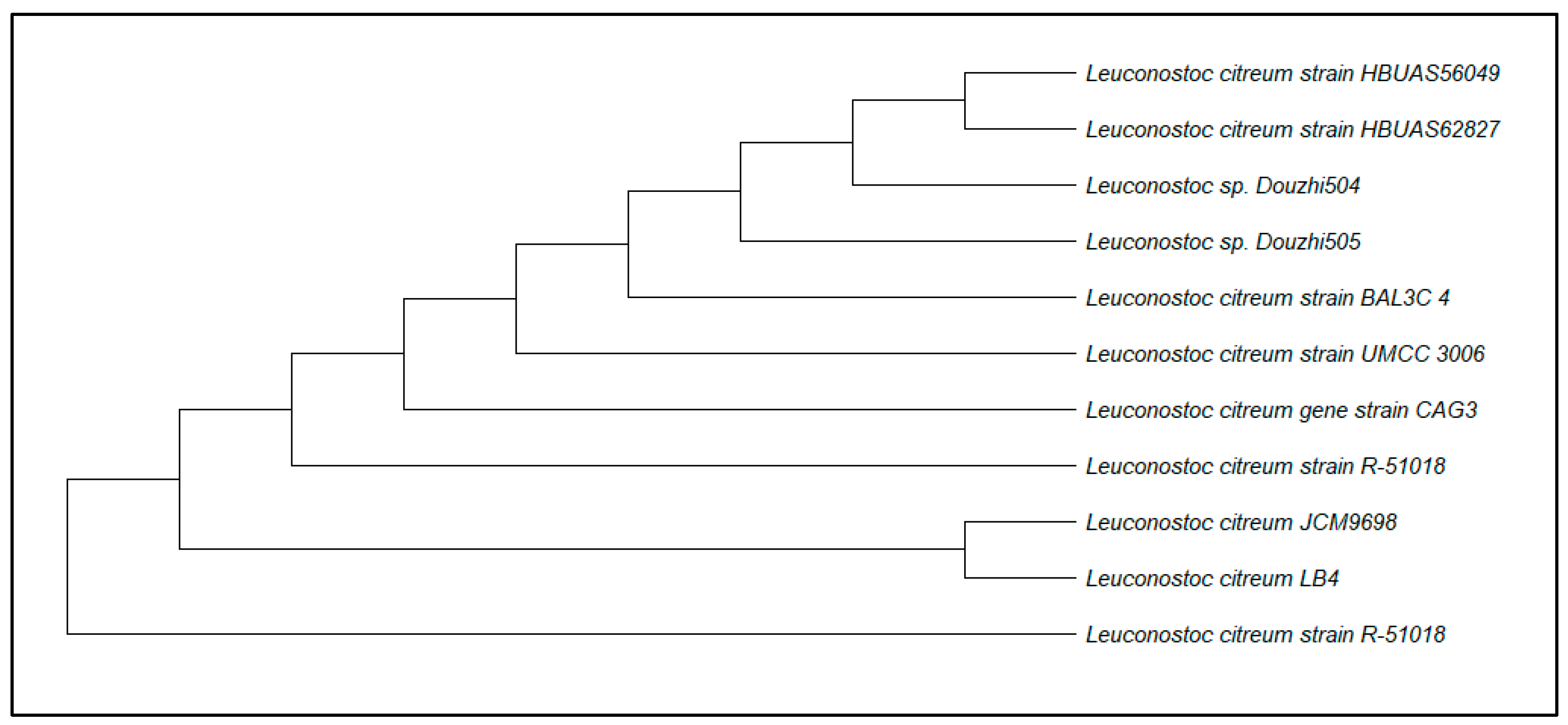

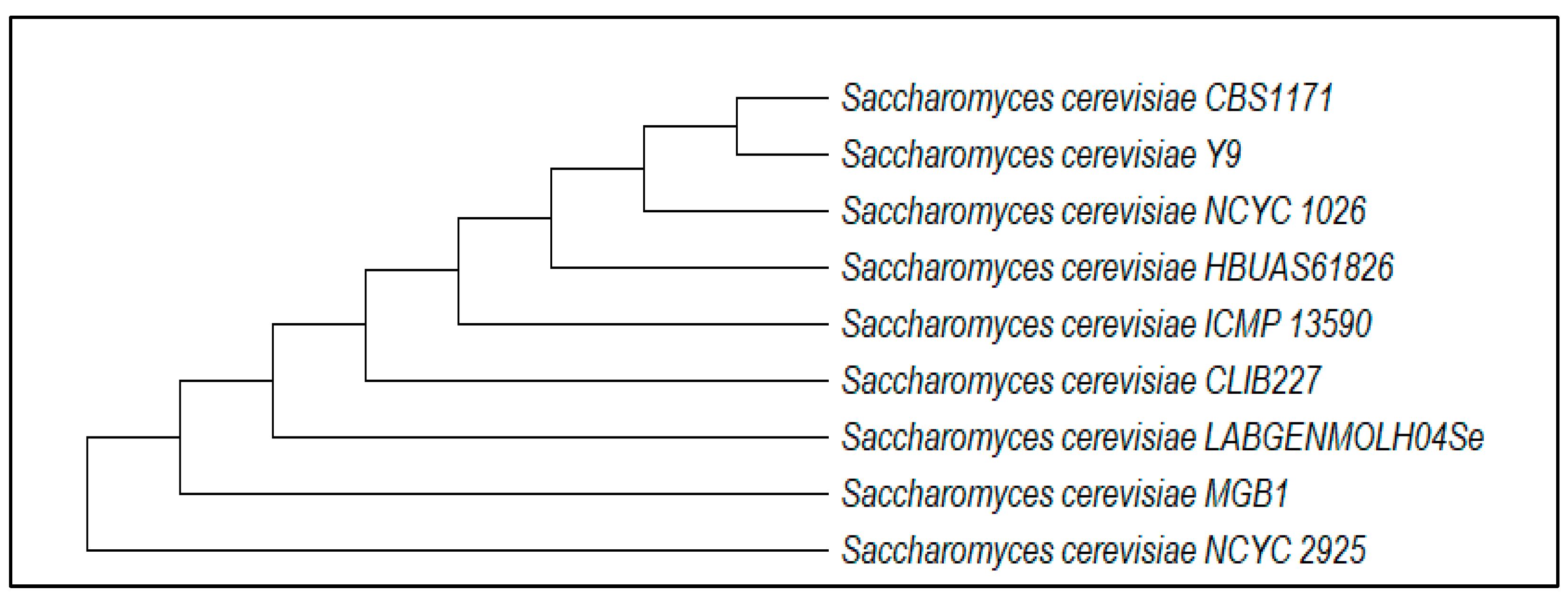
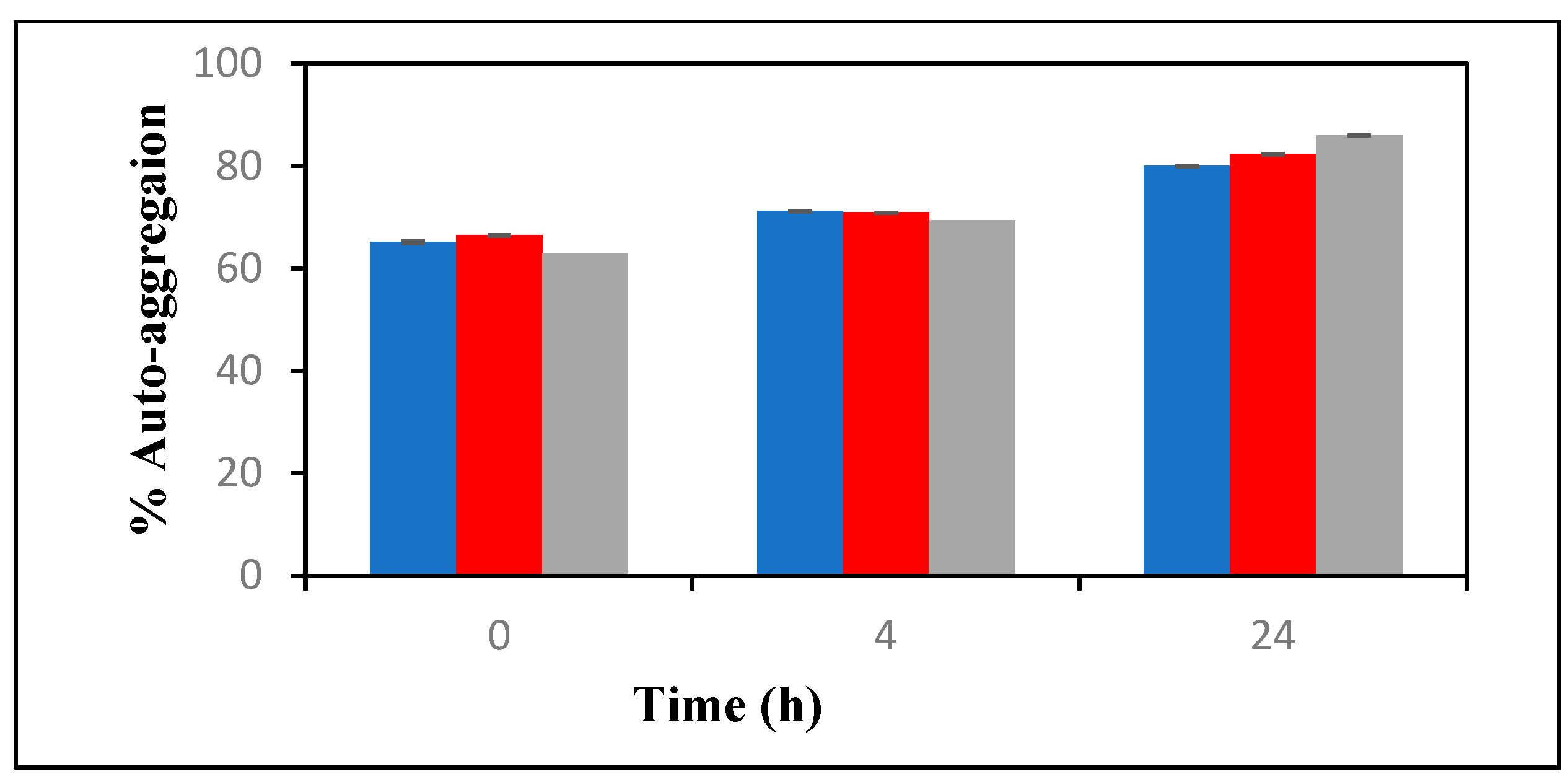
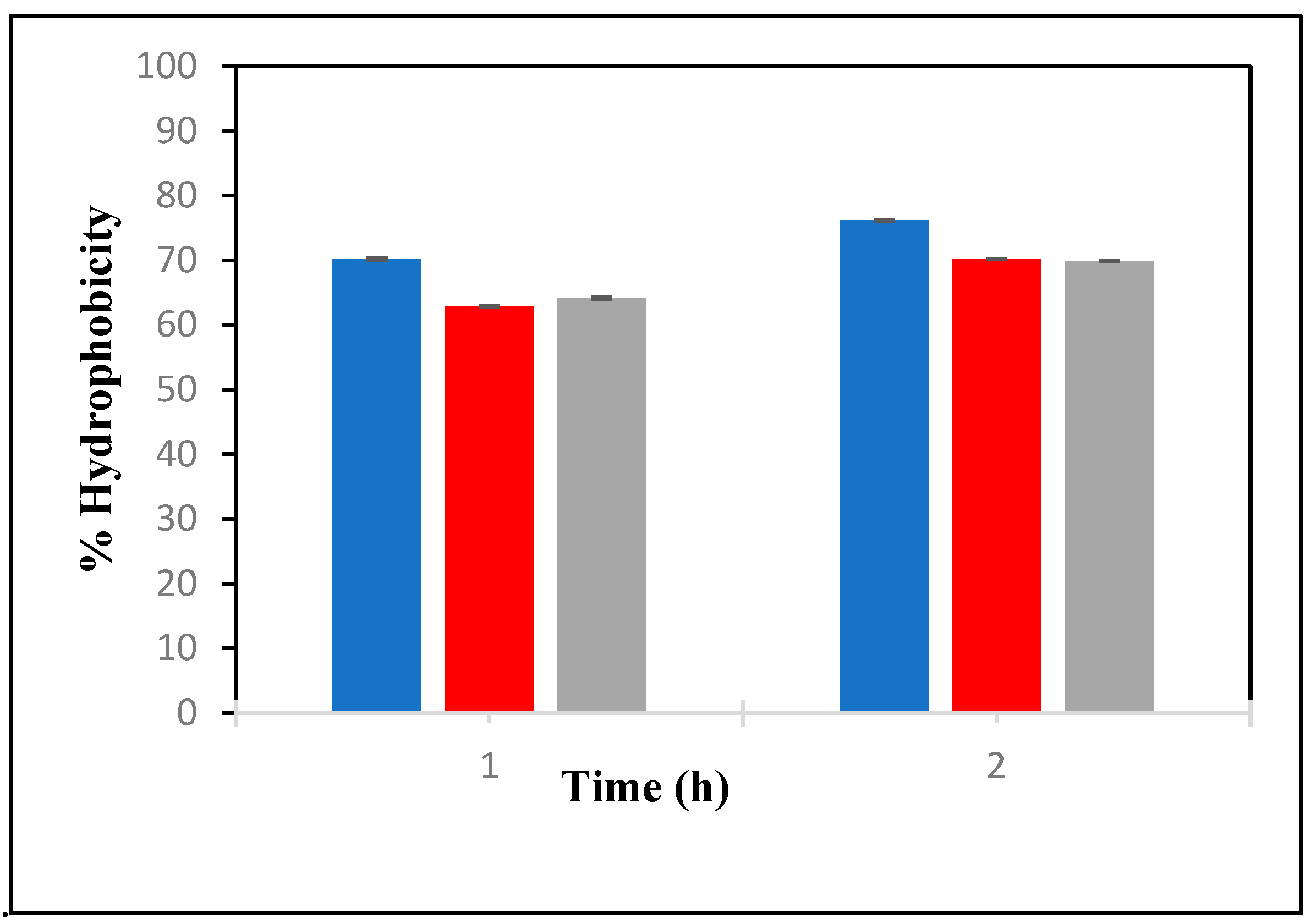
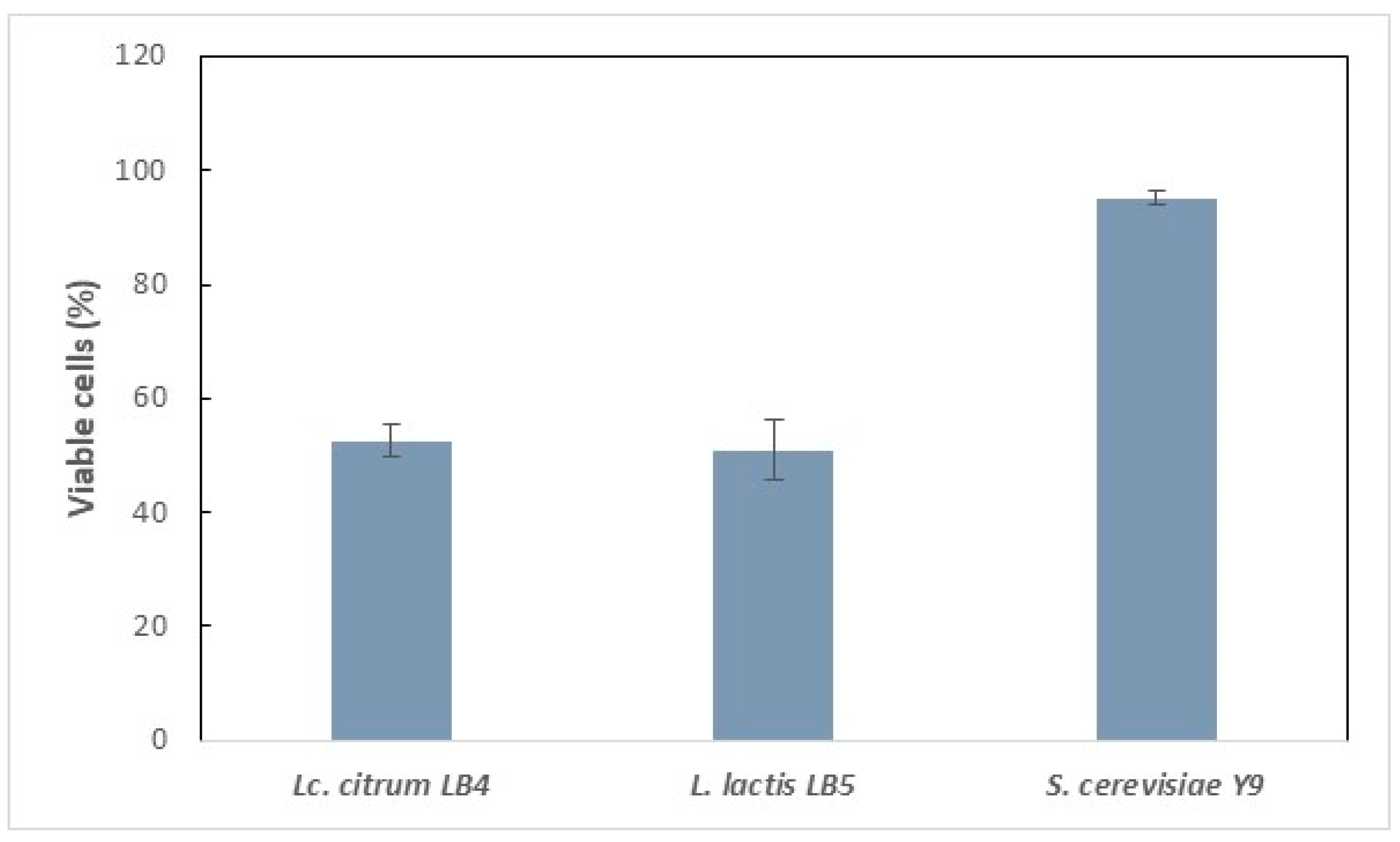



| Strain Designation | Species (16S,18S r DNA Gene Analysis) | Nearest Phylogenetic Neighbor | Identity (%) |
|---|---|---|---|
| LB4 | Lc. citreum | Lc. citreum (JCM9698) | 99.65% |
| LB5 | L. lactis | L. lactis (DSM20481) | 99.58% |
| LB6 | Lc. citreum | Lc. citreum (JCM9698) | 99.51% |
| LB13 | Lc. citreum | Lc. citreum (JCM9698) | 99.58% |
| LB25 | L. lactis | L. lactis (DSM20481) | 99.41% |
| Y7 | S. cerevisiae | S. cerevisiae (CBS1171) | 97.29% |
| Y9 | S. cerevisiae | S. cerevisiae (CBS1171) | 99.01% |
| Y10 | S. cerevisiae | S. cerevisiae (CBS1171) | 97.63% |
| Strain | ∆OD600nm at pH 3 | ∆OD600nm at pH 4 | ∆OD600nm at 4% NaCl | ∆OD600nm at 6% NaCl | ∆OD600nm At 0.4%Bile Salt |
|---|---|---|---|---|---|
| Lc. citreum LB4 | 0.322 ± 0.13 | 0.532 ± 0.12 | 1.118 ± 0.098 | −0.222 ± 0.05 | 0.418 ± 0.18 |
| L. lactis LB5 | 0.416 ± 0.076 | 0.636 ± 0.013 | 1.131 ± 0.013 | −0.181 ± 0.12 | 0.667 ± 0.32 |
| S. cerevisiae Y9 | 0.161 ± 0.05 | 0.396 ± 0.042 | 0.614 ± 0.016 | 0.51 ± 0.081 | 0.131 ± 0.24 |
| Microorganism | Media Growth Inhibition Halos (in mm) | Chloramphenicol (30 µg) | |||
|---|---|---|---|---|---|
| Lc. citreum LB4 | Lc. lactis LB5 | ||||
| PS | NS | PS | NS | ||
| Escherichia coli ATCC11229 | 14 ± 0.03 a | 13 ± 0.011 b | 16± 0.002 c | 16 ± 0.01 c | 15 ± 0.03 c |
| Shigella sonnei ATCC25931 | 15 ± 0.0015 a | 14 ± 0.003 b | 15± 0.09 a | 12 ± 0.017 c | 14 ± 0.072 b |
| Staphylococcus aureus subsp. aureus ATCC6538 | 14 ± 0.001 a | 14 ± 0.002 a | 14± 0.09 a | 14 ± 0.017 a | 12 ± 0.065 b |
| Salmonella thyphimirium ATCC14028 | 12 ± 0.0012 a | 10 ± 0.001 b | 13 ±0.014 a | 11 ± 0.024 c | 11 ± 0.021 c |
| Bacillus cereus ATCC 10876 | 15 ± 0.007 a | 15 ± 0.004 a | 15 ±0.012 a | 15 ± 0.045 a | 12 ± 0.04 c |
| Pseudomonas paraeroginosa ATCC9027 | 12 ± 0.023 a | 11 ± 0.0012 b | 13 ± 0.07 c | 12 ± 0.068 a | 13 ± 0.01 c |
| Antibiotic | Inhibition Halos (in mm) | |
|---|---|---|
| Lc. citreum LB4 | L. lactis LB5 | |
| Penicillin | 14 ± 0.01 | Resistant |
| Streptomycin | resistant | 13 ± 0.016 |
| Gentamicin | 16 ± 0.023 | 19 ± 0.012 |
| Ampicillin | Resistant | 14 ±0.05 |
| Olfaxin | 15 ± 0.033 | Resistant |
| Strain | Anti-Inflammatory Activity | |
|---|---|---|
| TNF-α Before LPS | TNF-α After LPS | |
| Lc. citreum LB4 | 563.22 a ± 465.21 | 1019.66 b ± 350.17 |
| L. lactis Lb5 | 1026.4 a ± 84.55 | 1253 b ± 22.91 |
| S. cerevisiae Y9 | 311.505 a ± 88.74 | 451.62 b ± 119.549 |
| Probiotic Characteristics | Probiotic Isolates (Scores) | ||
|---|---|---|---|
| Lc. citreum LB4 | L. lactis LB5 | S. cerevisiae Y9 | |
| Acidity tolerance | 1 | 1 | 1 |
| Bile salt tolerance | 1 | 1 | 1 |
| Auto-aggregation activity | 1 | 1 | 1 |
| Hydrophobicity | 1 | 1 | 1 |
| Anti-microbial activity | 1 | 1 | nd |
| Antibiotic sensivity | 0.6 | 0.6 | nd |
| Total | 5.6/6 | 5.6/6 | 4.0/4 |
| CCP (%) | 93.33 | 93.33 | 100 |
| Formulation | Time (h) | Viable Cell Count of LAB (log10₀ UFC/mL) | Viable Cell Count of Yeasts (log10₀ UFC/mL) | Acidity (%) | pH |
|---|---|---|---|---|---|
| BF1 | 0 | 6.75 ± 0.16 a | 4.47 ± 0.12 a | 0.5 ± 0.04 a | 5.42 ± 0.05 a |
| 48 | 7.89 ± 0.15 b | 6.35 ± 0.19 b | 1.50 ± 0.05 b | 4.25 ± 0.02 b | |
| BF2 | 0 | 6.32 ± 0.32 c | 4.75 ± 0.02 c | 0.55 ± 0.01 a | 5.5 ± 0.07 a |
| 48 | 7.52 ± 0.01 d | 6.28 ± 0.01 d | 1.60 ± 0.01 c | 4.18 ± 0.01 c | |
| BF3 | 0 | 5.24 ± 0.05 e | 5.47 ± 0.01 e | 0.50 ± 0.02 a | 5.55 ± 0.03 a |
| 48 | 6.91 ± 0.06 f | 7.02 ± 0.04 f | 1.74 ± 0.03 d | 4.02 ± 0.015 d |
| Time (h) | Total Phenolic Content (mg GAE/mL) | ||
|---|---|---|---|
| BF1 | BF2 | BF3 | |
| 0 | 48.32 ± 0.011 a | 48.13 ± 0.18 a | 48.37 ± 0.022 a |
| 24 | 51.39 ± 0.014 b | 49.74 ± 0.08 c | 48.91 ± 0.011 a |
| 48 | 55.13 ± 0.01 d | 52.91 ± 0.023 e | 50.082 ± 0.05 c |
Disclaimer/Publisher’s Note: The statements, opinions and data contained in all publications are solely those of the individual author(s) and contributor(s) and not of MDPI and/or the editor(s). MDPI and/or the editor(s) disclaim responsibility for any injury to people or property resulting from any ideas, methods, instructions or products referred to in the content. |
© 2025 by the authors. Licensee MDPI, Basel, Switzerland. This article is an open access article distributed under the terms and conditions of the Creative Commons Attribution (CC BY) license (https://creativecommons.org/licenses/by/4.0/).
Share and Cite
Abdi, A.; Gatri, E.; Guilbaud, J.; Bouallagui, H.; Fadhlaoui, K.; Garrait, G.; Ayed, L. Co-Cultivation of Potential Probiotic Strains Isolated from Water Kefir for Fermented Green Tea Beverage. Fermentation 2025, 11, 169. https://doi.org/10.3390/fermentation11040169
Abdi A, Gatri E, Guilbaud J, Bouallagui H, Fadhlaoui K, Garrait G, Ayed L. Co-Cultivation of Potential Probiotic Strains Isolated from Water Kefir for Fermented Green Tea Beverage. Fermentation. 2025; 11(4):169. https://doi.org/10.3390/fermentation11040169
Chicago/Turabian StyleAbdi, Ameni, Emna Gatri, Justine Guilbaud, Hassib Bouallagui, Khaled Fadhlaoui, Ghislain Garrait, and Lamia Ayed. 2025. "Co-Cultivation of Potential Probiotic Strains Isolated from Water Kefir for Fermented Green Tea Beverage" Fermentation 11, no. 4: 169. https://doi.org/10.3390/fermentation11040169
APA StyleAbdi, A., Gatri, E., Guilbaud, J., Bouallagui, H., Fadhlaoui, K., Garrait, G., & Ayed, L. (2025). Co-Cultivation of Potential Probiotic Strains Isolated from Water Kefir for Fermented Green Tea Beverage. Fermentation, 11(4), 169. https://doi.org/10.3390/fermentation11040169






